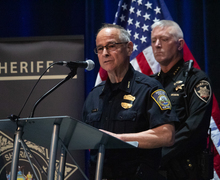Still life: Syracuse residents portray everyday life through multimedia project
Illustration by Tony Chao | Art Director
Dale Harp’s life goal is that no one will have to follow in his footsteps.
Growing up in the Southside of Syracuse, Harp fell in with the wrong crowd and when looking back, labels himself a juvenile delinquent — something that has carried over into his adult life. After he spent time in jail, Harp quit drugs and alcohol and dedicated his life to teaching youth that the “gangster life” isn’t what it’s cracked up to be.
Harp, along with seven other residents of the Southside and Near Westside of Syracuse, will debut their photos and videos that document their everyday life in the exhibit “From Where We Stand” on Thursday at the Nancy Cantor Warehouse in downtown Syracuse.
The Stand, a community newspaper in the Southside of Syracuse, spearheaded the project. Unlike other workshops The Stand holds for Syracuse residents, “From Where We Stand” was done over the course of the summer and gave each participant a brand new Nikon 3200 DSLR camera granted by the Gifford Foundation.
After applying, each participant of the program was paired with a mentor to work with during the project. The mentors were volunteer graduate students and professors from the S.I. Newhouse School of Public Communications or local professional photographers.
Founded five years ago by Steve Davis, the newspaper and online journalism department chair, The Stand has conducted many different projects in order to bring in more community members to a voice for the area.
“The one thing we have found over time is that when we offer people the opportunity to take photographs for the website or the newspaper, they really respond to that. Everybody has taken a picture,” Davis said.
Ashley Kang, coordinator of the “From Where We Stand” project, said the participants were all excited to share their stories.
“Everyone had the same feeling that ‘The Stand speaks to me and it talks about my community that I live in,’” Kang said. ‘“I want to participate to share my story and document my family.’”
Nick Lisi was the project’s lead mentor in the sense that he worked with Davis and Kang starting early last spring in the beginning stages of the project and as a group, formulated the budget and put it together.
“I worked with them with the planning and helping find mentors, as well as bouncing ideas off the material, especially with the photography part of it, which is my expertise,” Lisi said.
Lisi mentored Ardena Harvey, a single mom who documented her son’s transition from high school to college. The heart and soul of the project, Lisi said, was getting to know someone he’s never met before.
Lisi brainstormed with Harvey and made suggestions on what types of shots to take, what situations might be worth photographing and what angles she should go for. He also taught her how to use the equipment, offering tips on how to shoot and edit photos and film video.
Harvey, who had never used a professional camera before, said Lisi was phenomenal and patient in being her mentor.
“I am a complete novice when it comes to technology,” Harvey said. “He showed me how to utilize the camera and its features, and he was very instrumental in helping me complete this project.”
Harvey said she first heard about “From Where We Stand” in an email from a friend, and she decided to participate in it because she wanted to portray her son, a young black man, in a positive way.
“I am a single parent, and I know locally here in Syracuse, young black men can be portrayed in a negative light,” Harvey said. “I wanted to do something a little different for that and this was the perfect opportunity.”
As an individual, Harvey said this project allowed her to step out of her comfort zone and gave her something to pass down to her grandchildren and great-grandchildren.
Harvey’s son will be attending George Washington University in Washington, D.C., on a full-tuition Air Force ROTC scholarship. This project, she said, is a token of appreciation for everyone who helped her and her son over the years.
“It really was a village that helped get him through graduation and get his supplies and let him and us travel to D.C.,” she said. “This is to give back to everyone who supported him to go to college, to reflect on it and review it in caption.”
—Asst. Feature Editor Clare Ramirez contributed reporting to this article.
Published on September 11, 2014 at 12:00 am
Contact Julissa: [email protected]




